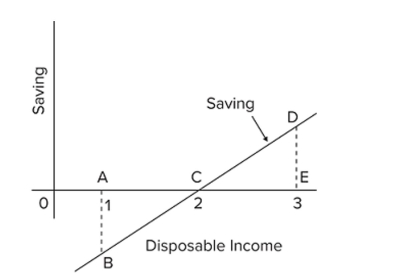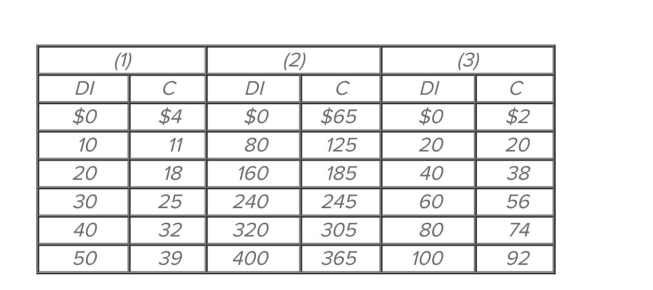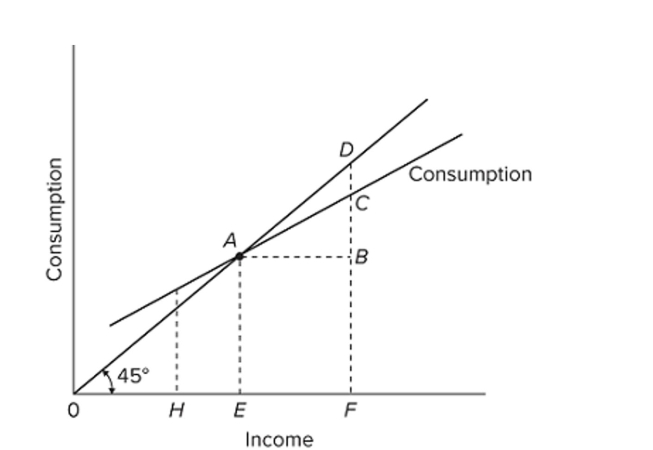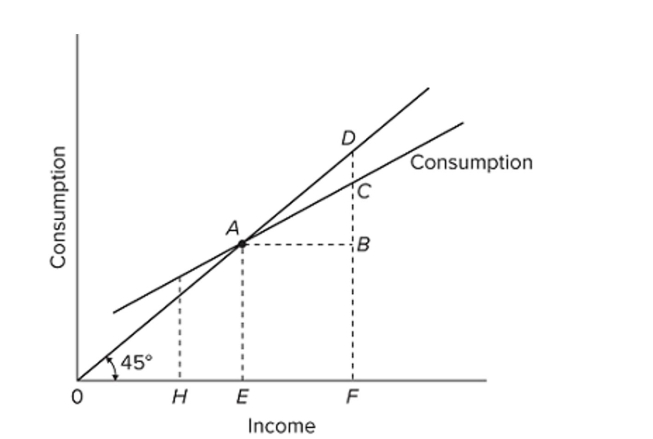Correct Answer

verified
Correct Answer
verified
Multiple Choice
The actual multiplier effect in the U.S. economy is less than the multiplier effect in the text examples because
A) the real-world MPS is larger than the MPS in the examples.
B) in addition to saving, households use some of any increase in income to buy imported goods and to pay additional taxes.
C) the gap between the nominal interest rate and the real interest rate widens as the economy expands or contracts.
D) the MPC in the United States is greater than 1.
Correct Answer

verified
Correct Answer
verified
Multiple Choice
A decline in disposable income
A) increases consumption by moving upward along a specific consumption schedule.
B) decreases consumption because it shifts the consumption schedule downward.
C) decreases consumption by moving downward along a specific consumption schedule.
D) increases consumption because it shifts the consumption schedule upward.
Correct Answer

verified
Correct Answer
verified
Multiple Choice
The table shows a consumption schedule. At the $300 level of disposable income,
A) the marginal propensity to save is 0.80.
B) the average propensity to consume is 0.60.
C) the average propensity to save is 0.30.
D) there is a dissaving of $10.
Correct Answer

verified
Correct Answer
verified
Multiple Choice
The numerical value of the multiplier will be smaller the
A) larger the average propensity to consume.
B) larger the slope of the saving schedule.
C) larger the slope of the consumption schedule.
D) smaller the slope of the saving schedule.
Correct Answer

verified
Correct Answer
verified
Multiple Choice
Refer to the given table, which illustrates the multiplier process. The marginal propensity to consume is
A) 0.5.
B) 0.75.
C) 0.8.
D) 0.9.
Correct Answer

verified
Correct Answer
verified
Multiple Choice
The size of the MPC is assumed to be
A) less than zero.
B) greater than one.
C) greater than zero but less than one.
D) two or more.
Correct Answer

verified
Correct Answer
verified
Multiple Choice
Which of the following is correct?
A) APC + APS = 1.
B) APC + MPS = 1.
C) APS + MPC = 1.
D) APS + MPS = 1.
Correct Answer

verified
Correct Answer
verified
Multiple Choice
Refer to the given table, which illustrates the multiplier process. The multiplier in this economy is
A) 2.
B) 4.
C) 5.
D) 10.
Correct Answer

verified
Correct Answer
verified
Multiple Choice
 Refer to the given saving schedule. As income falls from level 3 to level 2, the amount of
Refer to the given saving schedule. As income falls from level 3 to level 2, the amount of
A) dissaving decreases.
B) dissaving increases.
C) saving decreases.
D) saving increases.
Correct Answer

verified
Correct Answer
verified
Multiple Choice
Refer to the given data. If disposable income was $325, we would expect consumption to be
A) $315.
B) $305.
C) $20.
D) $290.
Correct Answer

verified
Correct Answer
verified
Multiple Choice
 The given figure suggests that
The given figure suggests that
A) consumption would be $60 billion even if income were zero.
B) saving is zero at the $120 billion income level.
C) as income increases, consumption decreases as a percentage of income.
D) as income increases, consumption decreases absolutely.
Correct Answer

verified
Correct Answer
verified
Multiple Choice
If households consume less at each level of disposable income, they are
A) saving more.
B) saving less.
C) spending more.
D) working less.
Correct Answer

verified
Correct Answer
verified
Multiple Choice
Suppose a family's consumption exceeds its disposable income. This means that its
A) MPC is greater than 1.
B) MPS is negative.
C) APC is greater than 1.
D) APS is positive.
Correct Answer

verified
Correct Answer
verified
Multiple Choice
 Refer to the given consumption schedules. DI signifies disposable income and C represents consumption expenditures. All figures are in billions of dollars. At an income level of $400 billion, the
Average propensity to save in economy (2) is
Refer to the given consumption schedules. DI signifies disposable income and C represents consumption expenditures. All figures are in billions of dollars. At an income level of $400 billion, the
Average propensity to save in economy (2) is
A) 0.9125.
B) 0.0725.
C) 0.0875.
D) 0.9305.
Correct Answer

verified
Correct Answer
verified
Multiple Choice
 Refer to the diagram. The marginal propensity to consume is
Refer to the diagram. The marginal propensity to consume is
A) 0.4.
B) 0.6.
C) 0.5.
D) 0.8.
Correct Answer

verified
Correct Answer
verified
Multiple Choice
 Refer to the given diagram. The marginal propensity to consume is equal to
Refer to the given diagram. The marginal propensity to consume is equal to
A) AE/0E.
B) CF/CD.
C) CB/AB.
D) CD/CF.
Correct Answer

verified
Correct Answer
verified
Multiple Choice
When the consumption schedule is plotted on a graph,
A) consumption is on the horizontal axis and saving is on the vertical axis.
B) consumption is on the vertical axis and saving is on the horizontal axis.
C) consumption is on the horizontal axis and disposable income is on the vertical axis.
D) consumption is on the vertical axis and disposable income is on the horizontal axis.
Correct Answer

verified
Correct Answer
verified
Multiple Choice
 Refer to the given diagram. The economy is dissaving
Refer to the given diagram. The economy is dissaving
A) in the amount CD.
B) at all income levels greater than E.
C) at income level H.
D) at income level E.
Correct Answer

verified
Correct Answer
verified
Multiple Choice
Assume a machine that has a useful life of only one year costs $2,000. Assume, also, that net of such operating costs as power, taxes, and so forth, the additional revenue from the output of this machine is Expected to be $2,300. If the firm finds it can borrow funds at an interest rate of 10 percent, the firm Should
A) not purchase the machine, because the expected rate of return exceeds the interest rate.
B) not purchase the machine, because the interest rate exceeds the expected rate of return.
C) purchase the machine because the expected rate of return exceeds the interest rate.
D) purchase the machine because the interest rate exceeds the expected rate of return.
Correct Answer

verified
Correct Answer
verified
Showing 21 - 40 of 233
Related Exams